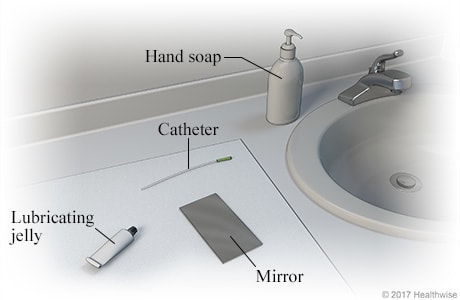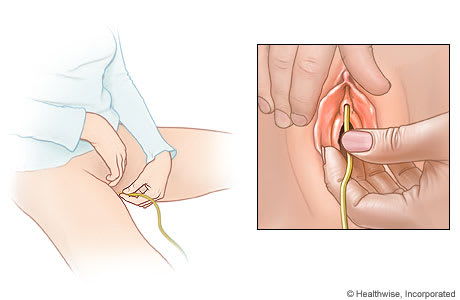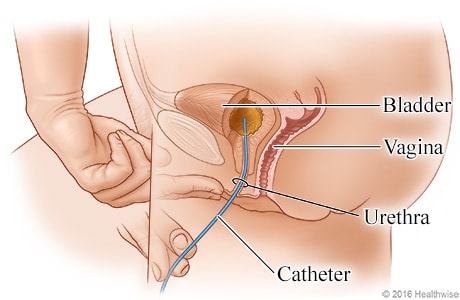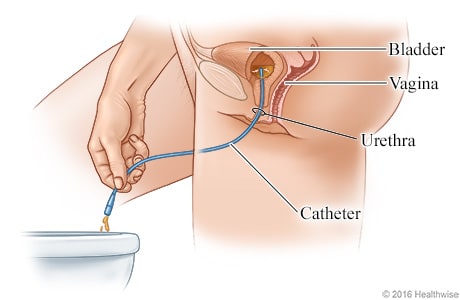Overview
Self-catheterization is a way to completely empty your bladder when you need to. You put a thin tube called a catheter into your bladder. This lets the urine flow out.
You may use a catheter if you have nerve damage, a problem with your urinary tract, or diseases that weaken your bladder muscles. Emptying your bladder regularly can prevent urine leaks during the day. It can also prevent kidney damage from blocked urine or infections.
Some urinary catheters are left in the bladder for as long as needed. But an intermittent, or straight, urinary catheter is taken out right after it is used. Straight catheters come in different lengths and types. Some types are used one time only. Others can be cleaned and reused. Your doctor or nurse will let you know what type you will need and where to get supplies.
Replace the catheter as instructed or before it wears out. Disposable catheters can be thrown away after each use.
You can empty your bladder every 4 to 6 hours, or as your doctor recommends. It takes practice to learn how to place the catheter. It may be uncomfortable at first, but it should not cause pain. If your doctor asks you to measure your urine, you can catch it in a container that is given to you. Note the amount of urine, the date, and the time.
It's very important to be clean when you use the catheter. This helps prevent infection. Keep your hands, the catheter, and the pubic area around your urethra clean. (When you urinate, the urethra carries urine from the bladder to the outside of the body. The urethra is just above the opening to the vagina.)
Follow-up care is a key part of your treatment and safety. Be sure to make and go to all appointments, and call your doctor if you are having problems. It's also a good idea to know your test results and keep a list of the medicines you take.
How can you care for yourself at home?
When you need to empty your bladder, try to urinate first, if you can, before you use the catheter.
Gather the supplies you need to insert the catheter.

You will need:
- The catheter.
- A mirror, if you want to use one.
- A container to hold the urine. (If you empty the urine right into the toilet, you won't need the container.)
- Lubricating jelly, such as K-Y Jelly, that dissolves in water. Don't use a petroleum jelly such as Vaseline.
You may want to use a clean washcloth or towel, plus a bag or plastic tub to hold the supplies.
Be sure to wash and dry your hands.
Find and clean the area around the urethra.

Choose a comfortable position with your legs spread. You may want to put one leg up on the toilet. Or you can lie on your back with your legs bent and spread in a "frog" position. Place the urine container (if you are using one) between your legs.
Separate the lips of your vulva (labia). Clean the area well with soap and water.
Spread the lubricating jelly on the tip of the catheter. Put the other end of the catheter over the toilet bowl or in the container to catch the urine.
Insert the catheter.

Gently insert the catheter into the urethra opening until urine begins to flow out. (You may want to use a mirror to see better.) Then insert it about 1 inch more.
Let the urine drain into the container or the toilet.
Drain the bladder and remove the catheter.

Remove the catheter slowly. If you are using a disposable catheter, throw it away. If not, wash it with warm, soapy water. Dry it and put it into a clean container.
Wash and dry your hands.
When should you call for help?
Call your doctor now or seek immediate medical care if:
- You have symptoms of a urinary tract infection. These may include:
- Pain or burning when you urinate.
- A frequent need to urinate without being able to pass much urine.
- Pain in the flank, which is just below the rib cage and above the waist on either side of the back.
- Blood or pus in your urine.
- A fever.
- Your urine smells bad.
- You can't pass any urine.
Watch closely for changes in your health, and be sure to contact your doctor if you have any problems.
Where can you learn more?
Go to http://www.healthwise.net/patientEd
Enter C162 in the search box to learn more about "How to Use a Straight Catheter for Self-Catheterization (Female): Care Instructions".
Current as of: November 15, 2023
Author: Ignite Healthwise, LLC Staff
Clinical Review Board
All Healthwise education is reviewed by a team that includes physicians, nurses, advanced practitioners, registered dieticians, and other healthcare professionals.

